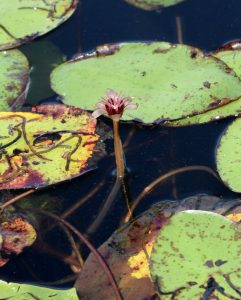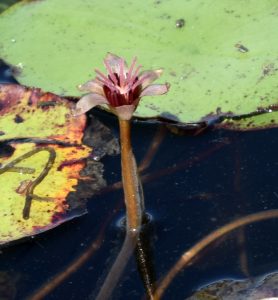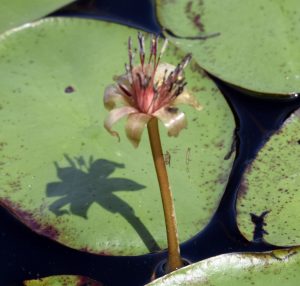Water-shield

Brasenia schreberi flowers range in color from purplish brown to pinkish red, appearing June through August among the yellow pond-lilies, white water lilies and other native aquatic species all sending their long stems upwards through warm, summer waters to unfurl their leaves onto the surface.
Below, they are supported by the rich, mucky soil of the lake bottom. Above, the air tickles their open flowers along with the multitude of feet, whisker and wings of lively creatures seemingly drawn to aquatic plants like magnets. And what’s not to like? Water shield seeds provide food for waterfowl, leaves and stems for muskrats to eat, while tubers and young leaves provide food traditionally for humans. Feel beneath water-shield’s leaves floating on the surface for the jellylike slimy coating here, on the stems, and on the developing flower buds. Look also for fish sheltering beneath these and the leaves of other water plants, and for insects resting here as well. Entire lives are lived within these water homes, with no need to look elsewhere for basic necessities.


Interestingly, water-shield relies on wind for pollination. Here’s how it works:
Despite their enticing, come-hither flowers (in my opinion) they are also rather small and inconspicuous (3/4″ wide) with a short bloom cycle of two days. On the first day, only the female parts, the pistils, are mature (similar to white water lily). On this first day, water-shield’s pistils emerge from the center, lengthen and spread outward over the petals and are receptive to pollen. At the end of the first day, the flower stalk then bends and is drawn underwater for the night. At dawn of the second day, the flowers reemerge from the water, this time with the pistils retracted and the male parts mature — the pollen-producing anthers. The stamen stalks have lengthened and the anthers are now open. In this way, the flowers achieve cross-pollination with nearby plants. After fertilization and blooming, the petals fold up and submerge (again similar to white water lily) into the protection afforded underwater. Enclosed in the petals and sepals, the fruit within develops into one or two seeds to ripen.
Water-shield is classified into the Water-shield family of plants. The Latin family name to which this corresponds is actually somewhat fun to say aloud: Cabombaceae!
